|
|
Created/dedicated as per personal communication with Britt Nibert, August 8, 2012
Updated as per James P. Tuttle's The Hawk Moths of North America, August 8, 2012
Updated as per BAMONA, August 8, 2012
|
Hunterdon County, New Jersey
Sphingidae
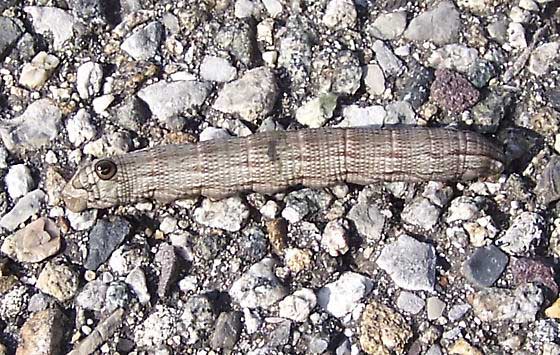
Sphecodina abbottii fifth instar (brown form),
Spruce Run Reservoir, Hunterdon County, New Jersey,
August 8, 2012, courtesy of Britt Nibert.
This site has been created by
Bill Oehlke at oehlkew@islandtelecom.com
Comments, suggestions and/or additional information/sightings are welcomed by Bill.
The page is inspired by and dedicated to Britt Nibert
(Hunterdon County), New Jersey. Britt has provided the
Sphecodina abbottii
larval image at top of this page.
Britt writes, "At first look it looked like a stick, the same color as the road. Large and fat and slow."
For care of "found larvae/caterpillars" visit Manduca sexta larva, central
Texas, August 21, 2008, Trina Woodall.
Forty-five Sphingidae species are listed for New Jersey on the BAMONA
website. Not all of the species are reported or anticipated in
Hunterdon County (eleven
are reported by BAMONA as of August 8, 2012). It is hoped
that this checklist, with the thumbnails and notes, will help you
quickly identify the caterpillars you are likely to encounter.
A "WO" after the species name indicates that
I (William Oehlke) expect that this species is present or
might be present, although unreported.
Please help me develop this list with improved, documented accuracy
by sending sightings (species, date, location), preferably with an
electronic image, via email to
Bill Oehlke.
Please also forward you sightings to BAMONA, an excellent on-line resource.
Visit Hunterdon County Sphingidae: Sphinx Moths; Hawkmoths
Visit New Jersey Catocala: Underwing Moths
If you are travelling, you can find active Sphingidae checklists for all countries in North, Central, and South America and the Caribbbean via the links at
North, Central, South American Sphingidae checklists
 |
Ceratomia amyntor
WO,
the Elm Sphinx or Four-horned Sphinx.
Caterpillars show both brown and green forms and are unmistakeable
due to four horns on the thorax (near the head).
Larvae feed on Elm (Ulmus), birch (Betula), basswood (Tilia), and
cherry (Prunus). |
 |
Ceratomia catalpae
WO,
the Catalpa Sphinx.
This caterpillar is one of the few North American Sphingidae that
feed in large groups. Colouration is distinctive. The larvae
are much more spectacular than the moths. Catalpa is the larval host.
Seen in Pottersville; WO |
 |
Ceratomia undulosa
BAMONA, the Waved
Sphinx.
Note the pinkish-orange tail, spiracles outlined in red and the cream
stripes on the head.
The dramatic color change from the dorsal
yellow-green to the lateral light greyish-blue is not always
as intense as in this image. Seen in Pottersville; WO
|
 |
Dolba hyloeus
BAMONA, the Pawpaw Sphinx.
Note the smooth skin, blue-black horn and small black spiracles.
Pawpaw is the primary host. Littleleaf sweetfern, possum haw,
inkberry, tall gallberry holly and others are also utilized.
|
 |
Lapara bombycoides
WO, the
Northern Pine Sphinx.
This caterpillar is also without the anal horn and feeds on pines.
The long stripes and reddish brown afford great camouflage.
|
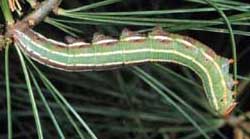 |
Lapara coniferarum
WO, the Southern Pine Sphinx.
This caterpillar is also without the anal horn and feeds on pines.
The long stripes and reddish brown afford great camouflage.
|
 |
Lintneria eremitus
WO, the
Hermit Sphinx.
Note triangular bump on the thorax.
Larval hosts are various species of beebalm (Monarda), mints (Mentha), bugleweed (Lycopis),
and sage (Salvia).
|
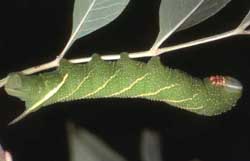 |
Manduca jasminearum
BAMONA, the Ash Sphinx.
Larvae feed on ash in the Fraxinus genus. Syringa and Ulmus have
also been reported.
Note the black anal horn. Seen in Pottersville; WO
|
 |
Manduca quinquemaculatus
WO,
the Five-spotted Hawkmoth.
Note the solid black horn and dark spiracular rings. In addition to the white
oblique lines, there are fainter white rings, especially on the back.
I suspect if you grow tomatoes, you are likely to encounter it. Seen in Pottersville; WO
|
 |
Manduca rustica
WO, the Rustic Sphinx.
Note the green horn, raised white bumps and strong dark lines
anterior to the white ones.
|
 |
Manduca sexta
WO, the Carolina Sphinx.
Note the red horn and black dots anterior to the white oblique lines.
If you grow tomatoes, you have probably encountered it. Seen in Pottersville; WO
|
 |
Paratrea plebeja
WO, the Plebeian Sphinx.
Larvae feed at night, hiding on the underside of stems during the
day. Preferred hosts are common trumpetcreeper (Campsis radicans),
Florida yellow-trumpet (Tecoma stans), lilac
(Syringa species), and passionflower (Passiflora species). Questionable
|
 |
Sphinx chersis
BAMONA,
the Northern Ash Sphinx or Great Ash Sphinx. Note pale blue horn and the creamy-white stripes on head.
The yellow form has a red horn.
Larval hosts are ash, lilac, privet, cherry and quaking aspen.
|
 |
Sphinx drupiferarum
WO, the
Wild Cherry Sphinx.
Larvae hide in the day and feed primarily on cherry, plum, and apple
at night. Larvae have been found on Amelanchier nantuckensis
in Massachusetts and have been reared to pupation in Michigan on
Prunus serotina. Note purple oblique lines.
|
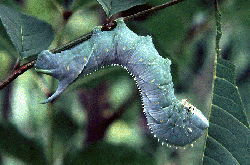 |
Sphinx franckii
BAMONA, Franck's Sphinx Moth.
Larvae feed exclusively on various species of ash (Fraxinus).
Raised, pointed bumps, especially near the head and thorax give this
caterpillar a reptilian appearance. maybe
|
 |
Sphinx gordius
WO, the
Apple Sphinx.
Larval hosts are apple (Malus), sweetfern (Myrica),
Carolina rose (Rosa carolina), blueberry and huckleberry
(Vaccinium), white spruce (Picea glauca), American
larch (Larix laricina), and alder (Alnus). Seen in Pottersville; WO
|
 |
Sphinx kalmiae
WO, the Laurel Sphinx.
In the final instar, the black on the head, lateral lines, horn and on abdominal
legs is diagnostic.Larvae feed primarily on lilac and fringe.
|
Smerinthini Tribe:
 |
Amorpha juglandis
WO,
the Walnut Sphinx.
Amorpha juglandis larvae feed upon Walnut and butternut (Juglans),
hickory (Carya), alder (Alnus), beech (Fagus),
hazelnut (Corylus), and hop-hornbeam (Ostrya).
Seen in Pottersville; WO
|
 |
Pachysphinx modesta
WO,
the Modest Sphinx or Poplar Sphinx.
This moth is not officially recorded in Morris County. It is fond
of poplars and
willows. maybe
|
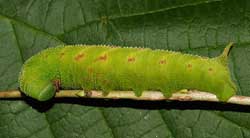 |
Paonias astylus
USGS, the Huckleberry Sphinx.
Blueberry and huckleberry (Vaccinium), cherries (Prunus) and willows (Salix) are the favorites as larval foodplants.
|
 |
Paonias excaecata
BAMONA,
the Blinded Sphinx.
Larvae accept willows, birches, and cherries.
I have also found them in the wild on oak in eastern Canada.
Seen in Pottersville; WO
|
 |
Paonias myops
WO, the Small-eyed Sphinx.
Wild cherry species are the favorites as larval foodplants, but eggs
will also be deposited on birches and other forest trees.
There are varying degrees in the amount of red markings along the sides.
Seen in Pottersville; WO
|
 |
Smerinthus jamaicensis
WO,
the Twin-spotted Sphinx.
Larvae feed upon many forest trees including birches and cherries,
but are expecially fond of poplars and willows. Red markings on sides
vary greatly from specimen to specimen.
Seen in Pottersville; WO
|
Macroglossinae subfamily
Dilophonotini tribe:
See Hemaris comparison to help distinguish
the next three species.
 |
Hemaris thysbe
WO, the Hummingbird Clearwing.
There is also an orangey-pink prepupal form. The lateral line runs
from S1 to the blue horn.
Hemaris thysbe larvae feed on viburnum and related plants.
Seen in Pottersville; WO
|
 |
Hemaris diffinis
BAMONA, the
Snowberry Clearwing or Bumblebee Moth.
Larval host plants include Snowberry (Symphoricarpos),
honeysuckle (Lonicera), Coralberry, viburnums, Blue Dogbane
(Apocynum) and dwarf bush honeysuckle (Diervilla lonicera).
Horn is black with a yellow base.
|
 |
Hemaris gracilis
WO, the
Slender Clearwing or Graceful Clearwing.
Hemaris gracilis is distinguished from similar species by a pair of
red-brown bands on the undersides of the thorax, which varies from
green to yellow-green dorsally and sometimes brown with white
underneath. They have a red abdomen. unlikely
|
Philampelini tribe:
 |
Eumorpha achemon
BAMONA,
the Achemon Sphinx.
Larvae feed upon Grape (Vitis), Virginia Creeper
(Parthenocissus quinquefolia) and other vines and ivies
(Ampelopsis).
Larvae occur in both a light (green) form and a darker (tan/brown)
form. Note six "segmented" oblique lines. Seen in Pottersville; WO
|
 |
Eumorpha pandorus
BAMONA, the Pandorus Sphinx.
If you have Grape or Virginia Creeper nearby, then you might encounter
this species.Note the five large white ovals. There are orangey-brown and green
forms also. Seen in Pottersville; WO
|
Macroglossini tribe:
 |
Amphion floridensis
BAMONA,
the Nessus Sphinix.
In additon to Virginia creeper larvae accept Grape (Vitis),
ampelopsis (Ampelopsis), and cayenne pepper (Capsicum).
Larvae are green until the final instar.
|
 |
Darapsa choerilus
WO, the Azalea Sphinx.
Larvae feed on Azalea and Viburnum and progress very rapidly. The
larva to the left on Viburnum cassinoides is getting ready to
pupate. Color change from green to light burgundy-brown indicates
pupation is imminent. Seen in Pottersville; WO
|
 |
Darapsa myron
WO, the Virginia Creeper Sphinx or the
Grapevine Sphinx.
If you have the
foodplants indicated in the common names, you probably have this
species nearby. The lower wings are orange.
Larvae feed on Virginia creeper (Parthenocissus quinquefolia),
Grape (Vitis), Ampelopsis, and Viburnum. Seen in Pottersville; WO
|
 |
Darapsa versicolor
WO,
the Hydrangea Sphinx.
Larvae feed on Smooth hydrangea (Hydrangea arborescens),
buttonbush (Cephalanthus occidentalis), and waterwillow
(Decodon verticillatus).
Note small head which can be retracted into the thorax.
|
 |
Deidamia inscriptum
BAMONA,
the Lettered Sphinx.
Grape (Vitis), ampelopsis (Ampelopsis), and
Virginia creeper (Parthenocissus) all serve as larval hosts.
The alternating yellow and greyish-green rings across the back
distinguish this larva.
|
 |
Hyles lineata
WO, the White-lined Sphinx.
Larvae are highly varied and feed on a great diversity of plants
including willow weed (Epilobium), four o'clock (Mirabilis),
apple (Malus), evening primrose (Oenothera), elm
(Ulmus), grape (Vitis), tomato (Lycopersicon),
purslane (Portulaca), and Fuschia.
All larvae seem, however, to have the red/black swellings split by
dorso-lateral lines. Seen in Pottersville; WO
|
 |
Sphecodina abbottii
BN,
the Abbott's Sphinx.
Larvae feed at night on grape (Vitis) and ampelopsis
(Ampelopsis) and hide on the bark of their host plants during
the day. Virginia creeper would also be a suitable host. There is also a dark form
without the green patches. Note the "raised eye", replacing the anal horn.
|
Sphecodina abbottii larva, August 8, 2012, Spruce Run Reservoir, Britt Nibert
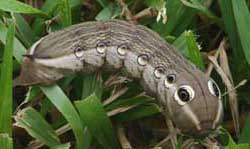 |
Xylophanes tersa
WO,
the Tersa Sphinx.
Larvae feed on Borreria, Catalpa
and Manettia spp. and
Smooth buttonplant (Spermacoce glabra) and starclusters
(Pentas species). They are also recorded on joe-pie weed and
Hamelia patens and on Hedoydis nigricans. The green form may be more
common. Seen in Pottersville; WO
|
Enjoy some of nature's wonderments, giant silk moth cocoons.
These cocoons are for sale winter and fall. Beautiful Saturniidae moths will emerge the following spring and summer.
Read Actias luna rearing article. Additional online help available.
Use your browser "Back" button to return to the previous page.
This page is brought to you by Bill Oehlke and the
WLSS. Pages are on space rented from Bizland. If you would like to become a "Patron of the Sphingidae Site", contact Bill.
Please send sightings/images to Bill. I will do my best to respond to requests for identification help.
 | 
Show appreciation for this site by clicking on flashing butterfly to the left.
The link will take you to a page with links to many insect sites. |
This website has been created and is maintained by Bill Oehlke without government or institutional financial assistance. All expenses, ie., text reference
support material, webspace rental from Bizland, computer repairs/replacements, backups systems, software for image adjustments (Adobe Photoshop; L-View),
ftp software, anti-virus protection, scanner, etc. are my own.
I very much appreciate all the many images that have been sent to me, or of which I have been granted permission to copy and post from other websites.
All images on this site remain the property of respective photographers.
If you would like to contribute to the maintenace of this website by sending a contribution to
Bill Oehlke
Box 476
155 Peardon Road
Montague, Prince Edward Island, C0A1R0
Canada
your donation would be much appreciated and would be used for
1) paying for webspace rental;
2) paying for computer maintenance and software upgrades;
3) purchases of additional text reference material (journals and books) in anticipation of expanding the site to a worldwide Sphingidae site;
4) helping to pay my daughter's tuition (completed spring of 2013); with anything left over going to humanitarian aid.
If you are mailing a check from USA, please use $0.85 postage. ($1.15 is 2014 rate so check with post office as rates are going up almost annually.) Donations can
also be made through Paypal via the button below.






































